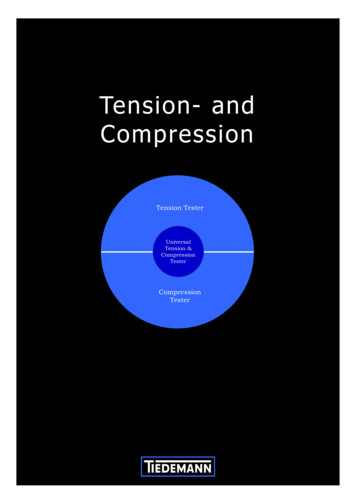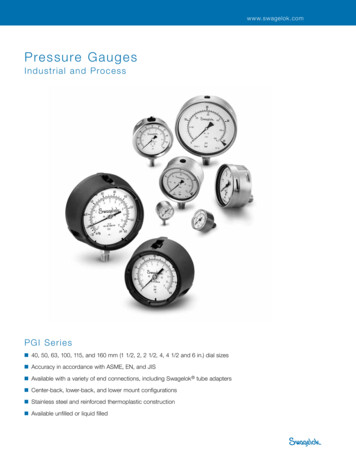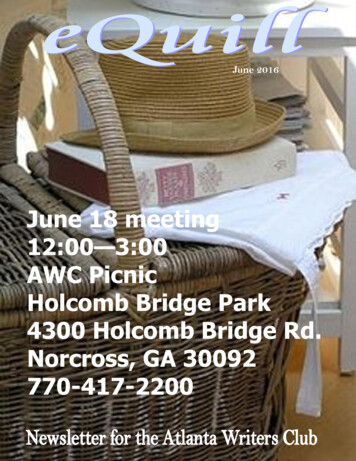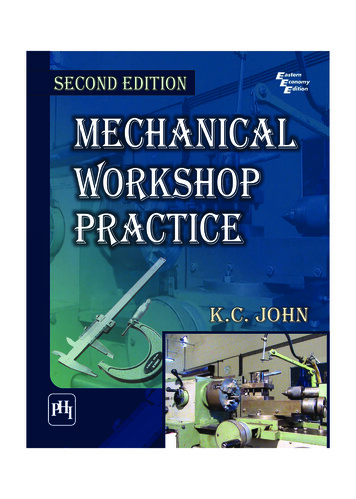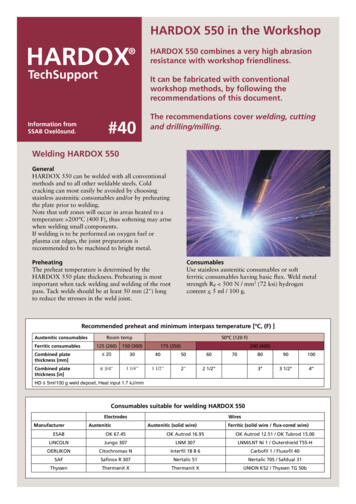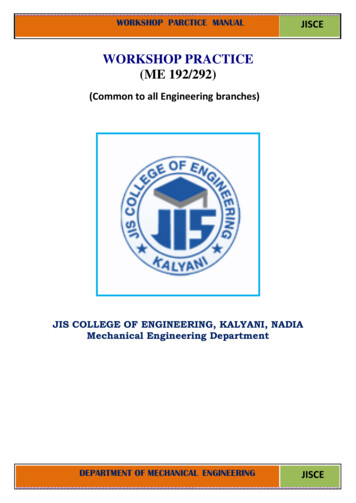
Transcription
WORKSHOP PARCTICE MANUALJISCEWORKSHOP PRACTICE(ME 192/292)(Common to all Engineering branches)JIS COLLEGE OF ENGINEERING, KALYANI, NADIAMechanical Engineering DepartmentDEPARTMENT OF MECHANICAL ENGINEERINGJISCE
Details of Laboratory:Lab in-charge: Mr. Bikash C BhuniaThe objective of this lab is to get a hands on knowledge of several Workshop Practices likecarpentry, fitting, welding, machining etc and learn safety regulations to be maintained in ashop floor. This laboratory is scheduled for 1 st and 2ndsemester for all engineeringstudents. Apart from curriculum, some additional experimental setups are there whichhelps the students to enhance their knowledge. Students also get opportunity to implementtheir ideas through various application oriented micro projects.SAFETY RULES & UNSAFE PRACTICESRemember that “accidents do not occur, they are caused”. With this in mind, strictly followthe general safety rules given below and safe practices indicated in brief under each section.1.Safety first, work next.2.Know your job and follow instructions.3.Avoid wearing clothing that might catch, moving or rotating parts. Long sleeves ofshirts, long hair, neck tie and jewellery are definite hazards in the shop.4.Wear safety shoes. Do not wear canvas shoes; they give no resistance to hardobjects dropped on the feet.5.Keep the area around machine or work clean.6.Keep away from revolving work.7.Be sure that all guards are in place.8.One person only should operate the machine controls.9.Use tools correctly and do not use them if they are not in proper working condition.10.Wear safety goggles when working in areas, where sparks or chips of metal areflying.11.Get to know who in-charge of first aid is and where boxes are placed and where thefirst aid can be found in case of emergency.
WORKSHOP PARCTICE MANUALJISCECourse Objective:To get a hands on knowledge of several Workshop Practices like carpentry, fitting, welding,machining etc and learn safety regulations to be maintained in a shop floor.Course Outcome:Upon completion of this laboratory course, students will be able toME 292.1. Fabricate components with their own hands.ME 292.2. Get practical knowledge of the dimensional accuracies and tolerances applicablefor different manufacturing processes.ME 292.3. Produce small devices of their interest for project or research purpose.Course Articulation ENT OF MECHANICAL ENGINEERINGJISCE
WORKSHOP PARCTICE MANUALJISCEC O N TE N T SSL.Experiment1.MAKING A SINGLE PIECEPATTERN2.MAKING A GAUGE IN MS PLATEPageno.143.MAKING A PIN FROM MSROUND BAR84.BUTT JOINT115.MAKE A S-HOOK FROM A GIVENROUND ROD17DEPARTMENT OF MECHANICAL ENGINEERINGJISCE
WORKSHOP PARCTICE MANUALJISCEPATTERN SHOPIntroductionA pattern is a model or the replica of the object (to be casted). It is embedded inmolding sand and suitable ramming of molding sand around the pattern is made.The pattern is then withdrawn for generating cavity (known as mold) in moldingsand.JOB NAME:- MAKING A PATTERNWorking Procedure:Sl.ProcedureNo.1Cutting as perLength fromthe long Woodpiece.InstrumentNameHand Saw, TrySquare, SteelRule & BenchVice.2Surface PlaneOf Top,Bottom, Front& Back Side oftheWood piece.Jack Plan &Bench Vice3Marking as per Pencile & TryDrawingSquareFig.DEPARTMENT OF MECHANICAL ENGINEERING1
WORKSHOP PARCTICE MANUAL4GrooveCuttingFlat Chisel&Ball PeenHammer5InclinedSurfaceCuttingFlat Chisel&Ball PeenHammerJISCELABORATORY EXERCISE:1.2.3.4.5.6.7.What are the basic safety required in Pattern Shop.What is pattern? State the function of pattern.What are the common materials used for pattern making. Discuss their merits anddemerits.What is the difference between pattern and casting?Define he core prints and core boxes with sketchExplain the various types of patterns used in foundry shop with sketch.How many type of pattern allowances?Mapping with CO and Bloom’s Taxonomy level:Question No.COBloom’s Taxonomy level111221321421521621721DEPARTMENT OF MECHANICAL ENGINEERING32
WORKSHOP PARCTICE MANUALJISCEFITTING SHOPIntroduction:The bench work and fitting plays an important role in engineering. Although intoday's industries most of the work is done by automatic machines whichproduces the jobs with good accuracy but still it (job) requires some handoperations called fitting operations. The person working in the fitting shop iscalled fitter.Fitting Tools:Fitting shop tools are classified as below:TOOLS REQUIRED WITH SPECIFICATIONSl. No.123Tools UsedMARKING TOOLSSteel Rule12” in lengthTry Square8” in lengthScriber10” in lengthCentre punch4” in lengthCUTTING TOOLSHack Saw300 X 12.5 X 0.67Cold Chisel12” in lengthFlat file12” in lengthSquare File8” in lengthSTRIKINGTOOLSBall Peen hammer4Specification0.5 Kg.HOLDING DEVICEFitter’s Vice6” or 8” jaw lengthDEPARTMENT OF MECHANICAL ENGINEERING4
WORKSHOP PARCTICE MANUALJISCEFig Hack SawSawHacksawsJOB NAME:- MAKING A GAUGE IN MS PLATEWORKING PROCEDURE:Sl.No.ProcedureInstrumentName1Make thePerpendicularFour cornerSide withRespect aParticular Base.Flat fileand TrySquare.2Marking as PerDrawing.Scriber, TrySquare,CenterPunch andHammerFig.DEPARTMENT OF MECHANICAL ENGINEERING5
WORKSHOP PARCTICE MANUAL3Cutting as perMarking.Hacksaw &vice4Make aThrough Hole.DrillMachine.5Make a Squarefrom The aboveHole.JISCESquare File &vice.LABORATORY EXERCISE:1.What are the basic safety required in Fitting Shop.2.State the functions of different shop in mechanical workshop.3.What are the different types of tools used in fitting shop? State their purpose ofuses. Draw some instruments figure.4.What are the uses of various types of files? Describe with sketch.5.What are the differences between the hammer used in carpentry shop, fitting shopand smithy shop with sketch.DEPARTMENT OF MECHANICAL ENGINEERING6
WORKSHOP PARCTICE MANUALJISCEMapping with CO and Bloom’s Taxonomy 431541DEPARTMENT OF MECHANICAL ENGINEERING7
WORKSHOP PARCTICE MANUALJISCEMACHINE SHOPMachine workshop Introduction:Machine shop is a place in which metal parts are cut to the required size and puttogether to form mechanical units or machines. The machines so made are to beused directly or indirectly in the production of necessities and luxuries of civilization.Machine shop is the base of all mechanical production.PRECAUTIONS:The following precautions should be taken during the experiment:a) Do not remove metal or wood chips from the table or stock by hand. Use a brush orother tool to properly remove chips or shavings from the table or stock.b) Never leave the key in the chuck. Do not let go of the key until it is free of the chuckand secured in its proper holding place.c) Never attempt to run the chuck on or off the spindle head by engaging the power.d) Do not stop the rotation of the chuck by reversing the power to the lathe unlesstappingholes.e) Do not leave tools, bits or excess pieces of stock on the lathe bed. All belts andpulleysmust be guarded.f) Stop the machine immediately if odd noise or excessive vibration occurs.JOB NAME:- MAKING A PIN FROM MS ROUND BARJOB FIGURE:OPERATING INSRTUCTIONS IN LATHE:DEPARTMENT OF MECHANICAL ENGINEERING8
WORKSHOP PARCTICE MANUALJISCE1. Ensure the serviceability of the apparatus & instruments.2. Ensure General cleanliness of the experimental setup.3. Check the calibration date of the instruments used (if any).4. The operating instructions are as follows:a) At first hold the work piece/job in chuck / face plateb) After holding the job, centering must be properly done for secured machiningprocess.c) Turn the chuck or faceplate by hand to ensure there is no binding or danger of thework striking any part of the lathe.d) Check to ensure the cutting tool will not run into the chuck. If possible, feed awayfrom the chuck.e) Before starting the lathe, ensure the spindle work has the cup center imbedded;tail stock and tool rests are securely clamped; and there is proper clearance for therotating stock.f) Prior to starting the lathe, ensure that small diameter stock does not project toofar from the chuck without support from the tail stock center.g) The operator must always be aware of the direction and speed of the carriage orcross feed prior to engaging the automatic feed.h) Select turning speed carefully. Large diameter stock must be turned at a very lowspeed. Always use the lowest speed to rough out the stock prior to final machining.i) The correct speed and feed for the specific material and cutting tool must be used.Stop the machine before making adjustments or measurements.j) After finished the work on the lathe, the power must be shut off and the machinemust come to a complete stop.DEPARTMENT OF MECHANICAL ENGINEERING9
WORKSHOP PARCTICE MANUALJISCELABORATORY EXERCISE:1.What are the basic safety required in Machine Shop.2.What is a machine tool?3.How a lathe is specified?4.Define cutting speed, feed and depth of cut in lathe.5.What materials are commonly used as cutting material?6.Write functions of lead screw and feed rod of a lathe machine.7.Name and explain five operations that can be performed on a lathe machine.8.What are the purpose of the cutting fluid? What are the types?9.What do you mean by nomenclature of cutting tool? Explain it with fig.Mapping with CO and Bloom’s Taxonomy level:QuestionNo.COBloom’s Taxonomylevel111211342441532643742842946DEPARTMENT OF MECHANICAL ENGINEERING10
WORKSHOP PARCTICE MANUALJISCEWELDING SHOPINTRODUCTION TO WELDING PROCESSESObjective:To study and observe the welding techniques through demonstration and practice ARCWELDING PROCESSES:Welding is a process in which two materials, usually metals, and is permanently joinedtogether by coalescence, resulting from temperature, pressure, and metallurgicalconditions. The particular combination of temperature and pressure can range from hightemperature with no pressure to high pressure with any increase in temperature. Thus,welding can be achieved under a wide variety of conditions and numerous weldingprocesses have been developed and are routinely used in manufacturing.To obtain coalescence between two metals following requirements need to be met: (1)perfectly smooth, flat or matching surfaces, (2) clean surfaces, free from oxides, absorbedgases, grease and other contaminants, (3e) metals with no internal impurities. These aredifficult conditions to obtain. Surface roughness is overcome by pressure or by melting twosurfaces so that fusion occurs. Contaminants are removed by mechanical or chemicalcleaning prior to welding or by causing sufficient metal flow along the interface so that theyare removed away from the weld zone friction welding is a solid state welding technique. Inmany processes the contaminants are removed by fluxing agents.The production of quality welds requires (1) a satisfactory heat and/or pressure source, (2) ameans of protecting or cleaning the metal, and (3) caution to avoid, or compensate for,harmful metallurgical effects.ARC WELDINGIn this process a joint is established by fusing the material near the region of joint by meansof an electric arc struck between the material to be joined and an electrode. A high currentlow voltageFig 4.1: The Basic circuit for arc weldingDEPARTMENT OF MECHANICAL ENGINEERING11
WORKSHOP PARCTICE MANUALJISCEFig 4.2: Schematic diagram of shielded metal arc welding (SMAW)Fig 4.3: Schematic diagram of gas metal arc welding (GMAW)electric power supply generates an arc of intense heat reaching a temperature ofapproximately 3800OC. The electrode held externally may act as a filler rod or it is fedindependently of the electrode. Due to higher levels of heat input, joints in thicker materialscan be obtained by the arc welding process. It is extensively used in a variety of structuralapplications. 6 There are so many types of the basic arc welding process such as shieldedmetal arc welding (SMAW), gas metal arc welding (GMAW), gas tungsten arc welding(GTAW), submerged arc welding Fig 4.1: The Basic circuit for arc welding Fig 4.2: Schematicdiagram of shielded metal arc welding (SMAW) Fig 4.3: Schematic diagram of gas metal arcwelding (GMAW) 7DEPARTMENT OF MECHANICAL ENGINEERING12
WORKSHOP PARCTICE MANUALJISCELABORATORY EXERCISEARC WELDINGJob Name: Butt JointMaterial Supplied: Mild steel plate of size 100X50X5 mm – 2 No’sWelding Electrodes: M.S electrodes 3.1 mm X350 mmWelding Equipment: Air cooled transformer Voltage-80 to 600 V 3 phase supply, ampsup to 350Tools and Accessories required:1.2.3.4.5.6.7.8.9.Rough and smooth files.ProtractorArc welding machine (transformer type)Mild steel electrode and electrode holderGround clampTongsFace shieldApronChipping hammer.Sequence of operations:1.2.3.4.5.6.7.8.9.MarkingCuttingEdge preparation (Removal of rust, scale etc.) by fillingTry square dure:1. The given M.S pieces are thoroughly cleaned of rust and scale.2. The two pieces are positioned on the welding table such that,3.4.5.6.the L shape is formed. The tongs are made use of for thepurpose.The electrode is fitted in the electrode holder and the welding current is ser tobe a proper value.The ground clamp is fastened to the welding table.Wearing the apron and using the face shield, the arc is struckand the work pieces are tack- welded at both the ends and atthe centre of the joint.The alignment of the corner joint is checked and the tack-welded pieces areDEPARTMENT OF MECHANICAL ENGINEERING13
WORKSHOP PARCTICE MANUALJISCErequired.7. The scale formation on the welds is removed by using the chipping hammer.8. Filling is done to remove any spanner around the weld.GAS WELDINGIn this process, a joint is established by fusing the material near the region of joint by meansof a gas flame. The common gas used is mixture of oxygen and acetylene which on burninggives a flame temperature of 3300OC. A filler rod is used to feed molten material in the gapat the joint region and establish a firm weld. The flame temperature can be controlled bychanging the gas composition i.e. ratio of oxygen to acetylene. The color of flame changesfrom oxidizing to neutral to reducing flame.LABORATORY EXERCISE:1.What are the basic safety required in Welding Shop.2.What are the different methods for metal joining?3.Give the definition of MMA welding4.What are the equipments used in MMA welding.5.State the difference between AC and DC welding.6.Why are edges prepared?7.What is an electrode?8.What are the common welding defects?9.What is root line?10.Draw a circuit diagram of MMA welding.11.Give the definition and state the principles of Oxy-acetylene gas welding/12.Draw the typical Gas-Welding circuit diagram.DEPARTMENT OF MECHANICAL ENGINEERING14
WORKSHOP PARCTICE MANUAL13.14.15.16.JISCEJISCEWrite notes on the followingi)Carburized Flameii)Neutral flameiii)Oxydised FlameWhy is the Oxygen cylinder kept lying on the floor.Why is Neutral flame used for welding.State the difference between soldering and brazing.Mapping with CO and Bloom’s Taxonomy level:QuestionNo.COBloom’s 441342144215421644DEPARTMENT OF MECHANICAL ENGINEERING1516
W o r WORKSHOPk s h o p P r a cPARCTICEt i c e M a n MANUALualJISCEJISCESMITHY SHOPIntroduction:Blacksmithy or Forging is an oldest shaping process used for the producing small articles forwhich accuracy in size is not so important. The parts are shaped by heating them in an open fireor hearth by the blacksmith and shaping them through applying compressive forces usinghammer.Hand forging process is also known as black-smithy work which is commonly production ofsmall articles using hammers on heated jobs. It is a manual controlled process even thoughsome machinery such as power hammers can also be sometimes used. Black-smithy is,therefore, a process by which metal may be heated and shaped to its requirements by the useof blacksmith tools either by hand or power hammer.COMMON HAND FORGING TOOLSFor carrying out forging operations manually, certain common hand forging tools are employed. Theseare also called blacksmith’s tools, for a blacksmith is one who works on the forging of metals in their hotstate. The main hand forging tools are as under.AnvilSwagDEPARTMENT OF MECHANICAL ENGINEERING17
W o r WORKSHOPk s h o p P r a cPARCTICEt i c e M a n MANUALualJISCEJISCEJob Name: To make a S-hook from a given round rod, by following hand forging operation.Tools required:Smith’s forge, Anvil, 500gm and I kg ball-peen hammers, Flatters, Swage block, Halfround tongs, Pick- up tongs, Cold chisel.Sequence of operations:1. One end of the bar is heated to red hotcondition in the smith’s forge for therequired length.2. Using the pick-up tongs; the rod is takenfrom the forge, and holding it with thehalf round tongs, the heated end isforged into a tapered pointed end.S- HOOK3. The length of the rod requires for S-hook is estimated and the excessportion is cut-off, using a cold chisel.4. One half of the rod towards the pointedend is heated in the forge to red hotcondition and then bent into circularshape as shown.5. The other end of the rod is then heatedand forged into a tapered pointed end.6. The straight portion of the rod is finallyheated and bent into circular shape asrequired.7. Using the flatter, the S-hook made asabove, is kept on the anvil and flattenedso that, the shape of the hook is proper.DEPARTMENT OF MECHANICAL ENGINEERING18
W o r WORKSHOPk s h o p P r a cPARCTICEt i c e M a n MANUALualJISCEJISCENOTE:In-between the above stage, the bar is heated in the smith’s forge, to facilitateforging operations.Result:The S-hook is thus made from the given round rod; by following the stagesmentioned above.Precautions:1.2.3.4.5.Hold the job carefully while heating and hammeringJob must be held parallel to the face of the anvil.Wear steel-toed shoes.Wear face shield when hammering the hot metalUse correct size and type of tongs to fit the work.LABORATORY EXERCISE:1.2.3.4.5.Explain in brief the various safety precautions associated with the forging shop.Sketch and describe the following :(A) Anvil(B) Swage Block(C) Set hammersDescribe press forging. How does it differ from drop forging?Explain in brief the defects in forging.What is the difference between Smithing and Forging ?Mapping with CO and Bloom’s Taxonomy level:QuestionNo.COBloom’s Taxonomylevel111212312412514DEPARTMENT OF MECHANICAL ENGINEERING19
2. State the functions of different shop in mechanical workshop. 3. What are the different types of tools used in fitting shop? State their purpose of uses. Draw some instruments figure. 4. What are the uses of various types of files? Describe with sketch. 5. What are the differences between the hammer used in carpentry shop, fitting shop
